Bat Path
Simply put, Bat Path is the route your bat travels to make contact with the pitch. This is one of the most important parts of the swing. Without the proper Bat Path, your whole swing will “fall apart”.If you were going to take a trip and weren’t sure of the correct way to get to where you are going, you would follow a map or GPS. This is the map of where your bat must go to get consistent contact with the baseball.
First, let’s look at a pitcher’s delivery and where the baseball is coming from.
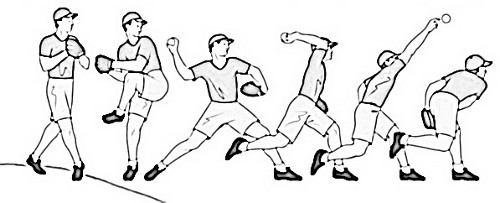
The pitcher is throwing from a mound that is ten inches high. So, he is already higher than the batter.
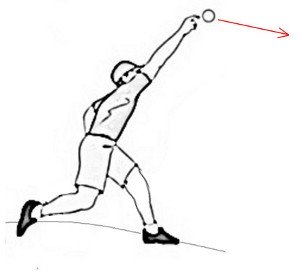
As the pitcher extends his arm to throw the pitch, the ball even higher. This baseball is clearly approaching the batter at a downward angle.
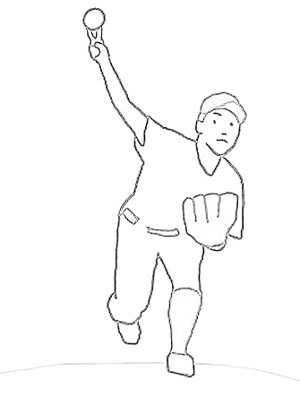
This is what it looks like to you, the hitter.
So, we have established that the path of the pitch is down toward the hitter.
The goal is to keep your bat on the same path as the pitch. Since the ball is coming toward you on a downward path, it's logical that you want to match that path with the barrel of your bat by swinging slightly upward.
The result of an upward path with your bat will be that the barrel of your bat will stay in the path of the baseball longer, giving you a much larger contact area.
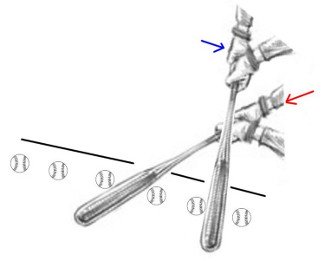
While keeping your bat on an upward path, if you are a little early with your swing you can still make contact a bit out in front of you and most likely pull the pitch. (Red Arrow).
If your swing is a little late, you can still make good contact farther back and hit the ball to your opposite field (Blue Arrow).
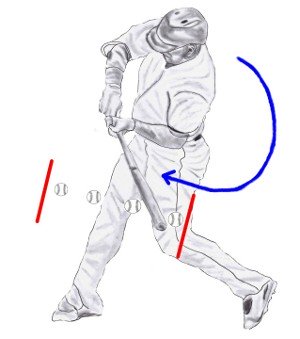
By keeping his bat on an upward path, this batter can hit this pitch anywhere between the red lines.
Now, let’s see what happens if you swing down at the pitch.
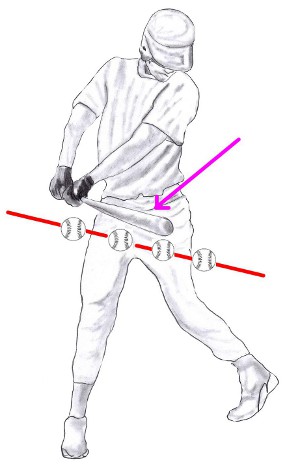
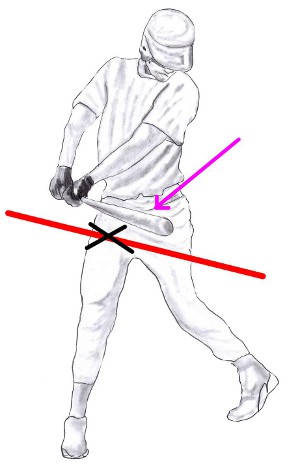
The blue arrow is this batter’s swing path. The red line is the path of the pitch. Where they intersect, the black X, is the only spot in the pitch path that this batter can hit the baseball.
And even if he does make contact, it will result in a chopping ground ball. The usual result of a swing like this is a swing and a miss.
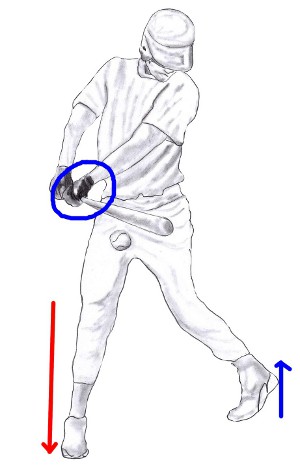
Swinging down at the pitch will cause other problems with your swing. This batter has his weight too far forward. So much that his rear foot is off the ground. Also, swinging down will cause your top hand to “roll over” much too soon resulting in a ground ball probably to your pull side.
His rear elbow should be very close to his body at contact. This hitter’s elbow is away from his body.
Swinging, chopping down at the pitch will cause your whole swing to fall apart.
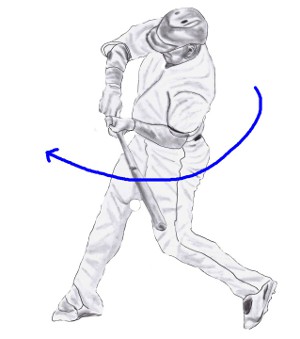
Let’s look at the same batter from before. His swing path is upward.
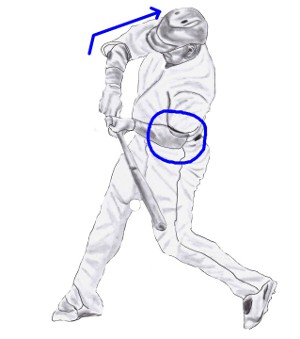
His front elbow and shoulder are pulling up and back. His rear elbow is close to his body. The result is a swing that is slightly up through the ball.
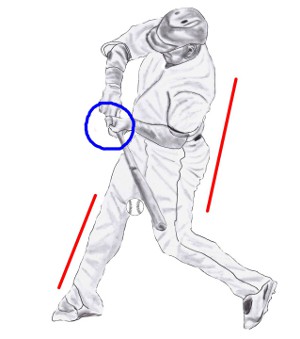
The palm of his top hand is up (Blue Circle). His body is tilted backward toward the catcher (Red Line). He has not collapsed his front leg. It’s stiff.
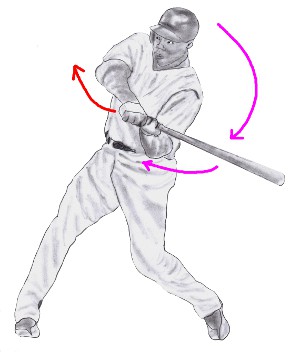
The knob of this batter's bat turns up as he swings on an upward path. The knob does not “go to” the ball.
His front elbow and shoulder are pulling up and back.
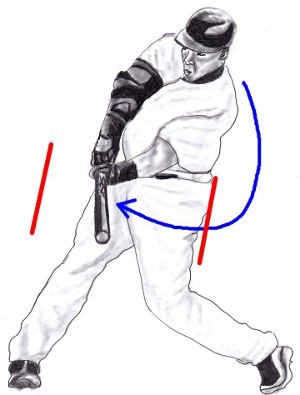
His bat is moving upward. Now he is able to make contact anywhere between the red lines.
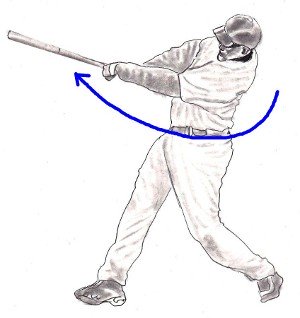
The arms extend fully AFTER contact. Notice his backward tilt.
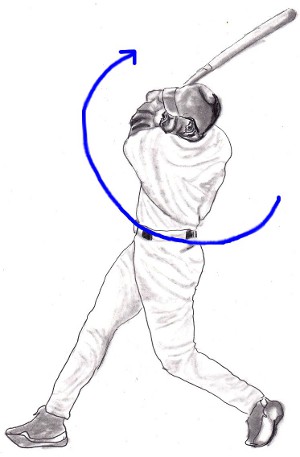
Now, his finish or follow through. He’s still tilted back. But notice where his bat is. THIS IS IMPORTANT. He finishes high. This is a clear indication that you are staying on the path of the pitch with your swing.
Hitters who swing down on the ball will finish with their bat low and their hands down near their hip.
One last tip. Keep your top hand very loose on the bat in your stance and throughout your swing. Your bottom hand and arm does most of the swing. Your top hand is just along for the ride. This will help keep your top hand palm facing up at contact.
Gripping the bat too tight will cause your top hand to roll over at contact resulting in a weak ground ball.
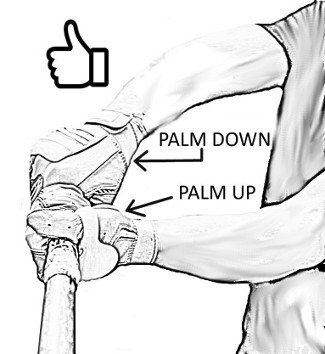
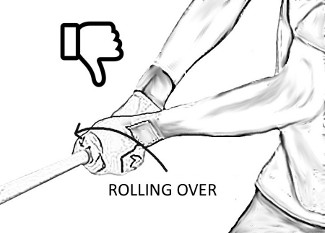
This is something you can practice on your own. Practice your swing in slow motion at first. All you need is a bat.
As you swing, make sure:
*Your bat path is coming up through the imaginary pitch.
*Rear elbow and hands close to your body as you swing.
*The palm of your top hand is facing up at contact. Keep your top hand loose.
*You are pulling your front shoulder and elbow up and back when you swing.
*You are tilted back toward the catcher at contact.
*You extend your arms AFTER contact.
*Make double certain that your finish your follow through high.
When you are taking batting practice, think about swinging up. When your bat is coming up through the ball, most of these other parts of the swing will happen automatically.
By swinging up, you WILL stay on the path of the pitch longer and I guarantee you will see more consistent contact.
I realize that this is a lot of information. But if you want to be a good hitter, this is what you must do.
Practice one thing at a time. Take ten swings at an imaginary pitch and focus on swinging upward. Then take ten swings and concentrate on tilting back toward the catcher. And so on.
The more you practice to parts of your swing, the faster your body will remember them. After awhile you won’t have to think about all these parts of the swing when you are hitting. So, practice often.
All Rights Reserved.